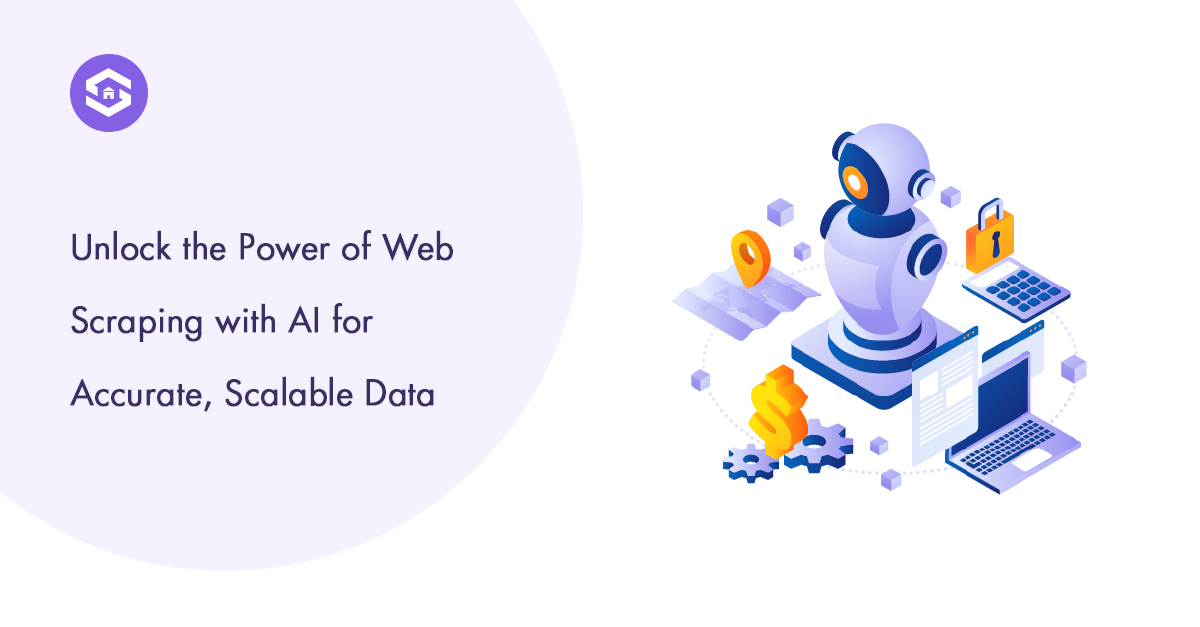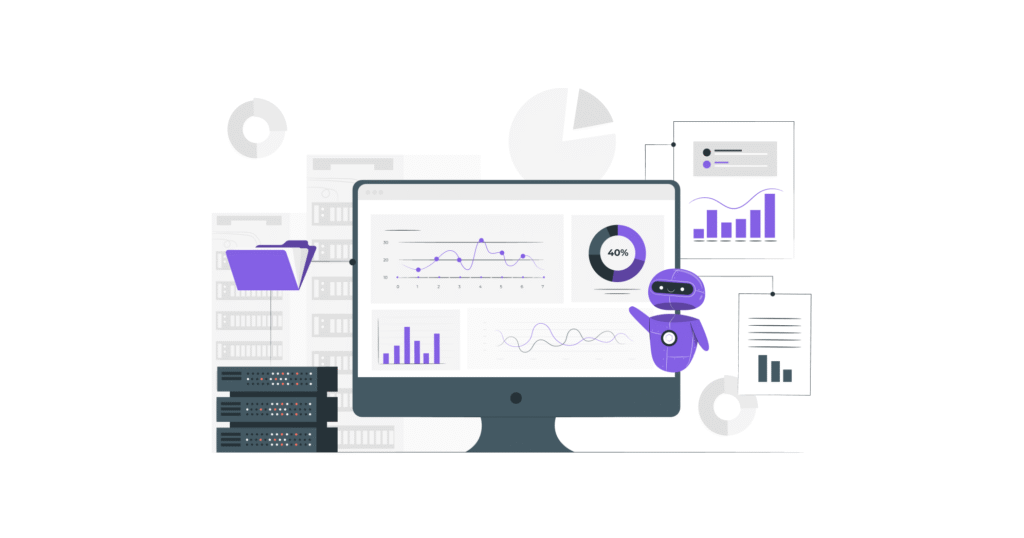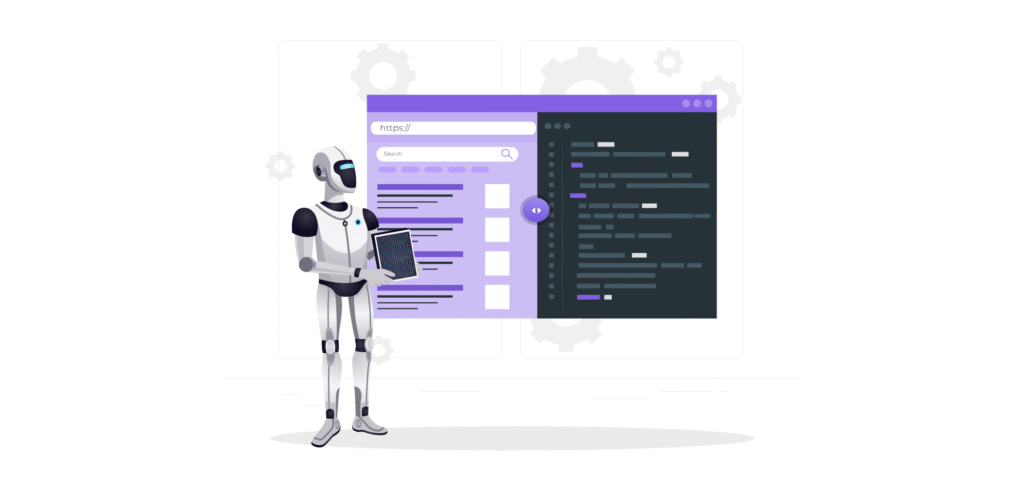How Web Scraping with AI Transforms Data Collection for Businesses
9 min read
9 min read

Table of Contents
Table of Contents
Using automated tools or scripts to extract data from websites is known as web scraping. This data is often organized and analyzed to support business strategies, offer insights, or enhance services. Modern advancements have introduced Web Scraping with AI, enabling more efficient retrieval, parsing, and extraction of relevant HTML content, taking traditional computer-based approaches to the next level.
Examples of applications include:
Modern websites, particularly those that use dynamic content or anti-scraping techniques, provide challenges for traditional methods.

Web Scraping with AI is revolutionizing the field by introducing advanced capabilities such as:
By integrating AI, web scraping develops into a powerful tool that may save time and money while adjusting to the complexity of modern websites.
Web scraping dates back to the early 2000s, when websites were primarily static HTML pages. Early scraping tools utilized simple methods:
These methods worked well for simple websites but began to fail as websites grew more complex and dynamic.
Dynamic Content: Websites increasingly rely on JavaScript to load content dynamically, which traditional scrapers often cannot process.
Anti-Scraping Measures: CAPTCHA, rate-limiting, and IP blocking have made accessing data harder for basic scrapers.
Frequent Website Changes: Updating scraping scripts for each website change is time-consuming and error-prone.
Integrating AI into web scraping addressed many of the limitations of legacy methods. Key advancements include:
Natural Language Processing (NLP): AI-powered scrapers understand the context of unstructured data, enabling them to extract meaningful information.
Computer Vision: Tools with AI can analyze images or visual layouts to identify patterns and extract data, such as product labels or screenshots.
Predictive Models: AI anticipates potential changes in website structures, ensuring seamless adaptation without manual intervention.
Real-Time Processing: AI enables scrapers to work on dynamic content, such as live sports scores or stock prices, in real-time.
These innovations in Web Scraping with AI have transformed the process from a manual, error-prone task into a sophisticated, automated solution capable of addressing the complexities of modern websites.
Traditional web scraping requires developers to create unique scripts for every website, update them whenever the website layout changes, and perform tedious, error-prone, and repetitive tasks. After collecting the data, they must clean and structure it, which becomes especially burdensome when handling large data sets.
Automation: The process of identifying data patterns and website structures can be automated with AI algorithms. Once trained, these AI models can adjust to layout changes without requiring code to be rewritten each time a website is changed.
Data Cleaning & Structuring: Unstructured data can be automatically processed by AI into structured, useable representations (such as CSV or JSON). This saves time and lowers the possibility of human error by doing away with the necessity for manual post-processing.
Scheduling & Triggers: To streamline the process and eliminate the need for continual guidance, AI-powered solutions can be configured to execute scraping activities regularly or in response to particular data conditions.
The human work required for web scraping is decreased by this AI-driven automation, giving developers and analysts more time to concentrate on drawing conclusions from the data rather than monitoring the scraping procedure.
The ever-changing nature of web pages is a challenge for traditional web scraping. A scraper’s usefulness may be compromised by any changes to a website’s design or content structure. Manual involvement is needed every time a change happens, resulting in inefficiency and downtime.
Adaptive Learning: AI models can continuously monitor a website’s structure and make adjustments as needed. An AI scraper can re-learn the new structure and adapt to any changes made to a website’s layout, such as a new navigation menu, extra fields, or an updated CSS class. Developers no longer have to update scraping scripts regularly.
Handling Dynamic Content: AI systems are designed to work with dynamic content that is rendered using JavaScript. They can navigate through content, click on elements, and retrieve data from pages that use JavaScript to display important information, much like a human would.
Predictive Capabilities: Based on past data, AI-powered web scrapers may even predict possible structural changes to a website, guaranteeing that it will continue to function even when web pages change. Compared with traditional scraping techniques, this capacity to anticipate changes before they occur offers a more reliable, long-term solution.
Scrapers can keep ahead of the curve because of AI’s versatility, which offers continuous, real-time data extraction without requiring constant oversight or manual updates.
To build a powerful AI-driven web scraper, several components work together in harmony. Here’s a breakdown of what’s needed:
These components work together to create a complete AI-driven web scraper that can effectively and accurately extract data from even the most complex websites.

Building your first AI-powered scraper may seem daunting, but breaking the process into manageable steps can make it much easier. Here’s how to do it:
1. Define Your Goal: Identify what information you need and why before you begin. To examine market trends, for instance, you might want to scrape product prices from an e-commerce site.
2. Choose the Right Tools: Choose the right libraries and tools for your scraper. TensorFlow or PyTorch are fantastic options for training machine learning models, whereas Scrapy is an excellent option for crawling. Selenium or BeautifulSoup can assist in handling dynamic content and parsing HTML.
3. Write the Crawler: Start by writing the crawler to fetch the necessary pages from the website. This might involve fetching HTML, parsing it, and extracting relevant links or content.
4. Train Your AI Model: Use machine learning techniques to train the AI model to find patterns in the data you want to extract. For example, when you’re scraping product information, you can use natural language processing (NLP) to teach the model to recognize product names, prices, and descriptions.
5. Handle Dynamic Content: Use tools such as Selenium or Puppeteer to mimic user behaviour on dynamic websites and extract data generated by JavaScript.
6. Integrate Components: Integrate the dynamic content handler, AI model, and crawler into a single process. This step ensures that the system can extract and structure data from beginning to end without any problems.
7. Schedule and Automate: To execute your scraper at regular times, set up a scheduler. This eliminates the need for continuous monitoring and guarantees that your data collection is current and reliable.
Testing and optimization are key to building a robust AI-driven scraper. Here’s how to ensure your scraper runs smoothly:
1. Test with Real Data: Test the scraper first on live websites. Keep your focus on its ability to identify the data you want to extract and how well it manages various page structures.
2. Validate Extracted Data: Verify the extracted data’s accuracy by comparing it to the webpage. Any disparities should be noted and fixed in the AI model.
3. Optimize Performance: To make your scraper run faster, consider using asynchronous requests or multithreading. These methods greatly increase efficiency by enabling the scraper to submit several requests simultaneously.
4. Handle Anti-Scraping Mechanisms: Some websites use anti-scraping strategies like CAPTCHA, IP blocking, and rate-limiting. When permitted by legislation, AI can bypass these protections by mimicking human browsing patterns by rerouting IP addresses, delaying requests, or changing user agents.
5. Iterate and Improve: The act of web scraping is a continuous process. As websites change, so should your scraper. Keep monitor the scraper’s performance, fix any issues, and update the AI model as needed.
By following these steps, you’ll have a powerful, adaptable, and efficient AI-driven scraper that can handle complex data extraction tasks with ease.
In conclusion, web scraping with AI has revolutionized data collection for businesses, making it faster, more accurate, and highly scalable. By leveraging AI-driven tools, companies can efficiently extract valuable insights from vast online data sources, enabling smarter decision-making and competitive advantages. Whether it’s market analysis, customer behaviour tracking, or trend forecasting, AI-powered web scraping is a game-changer for businesses aiming to thrive in the digital age.